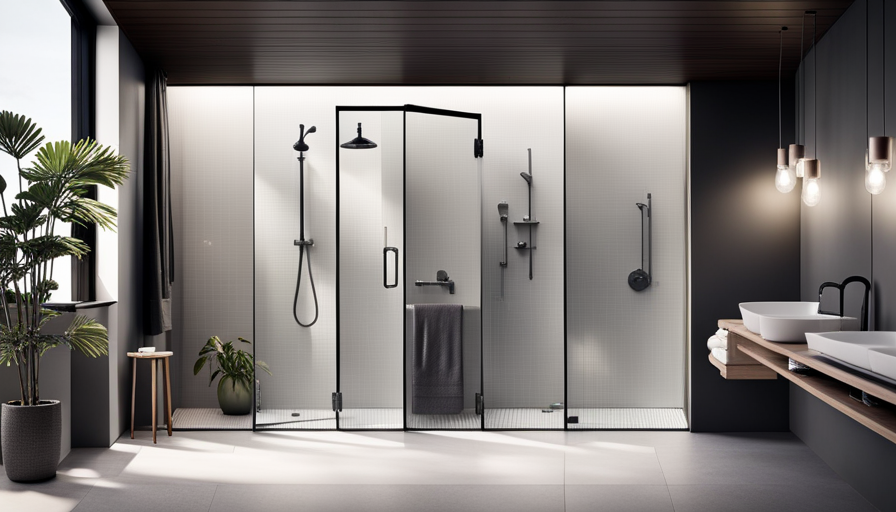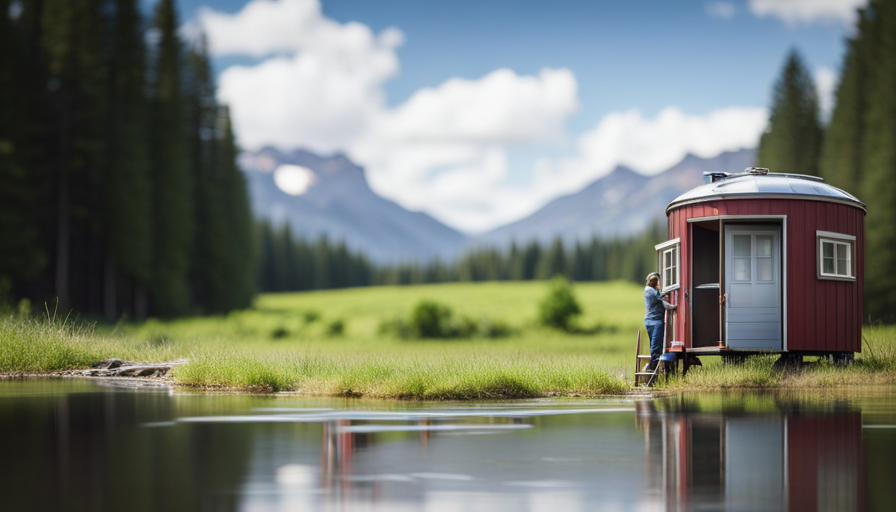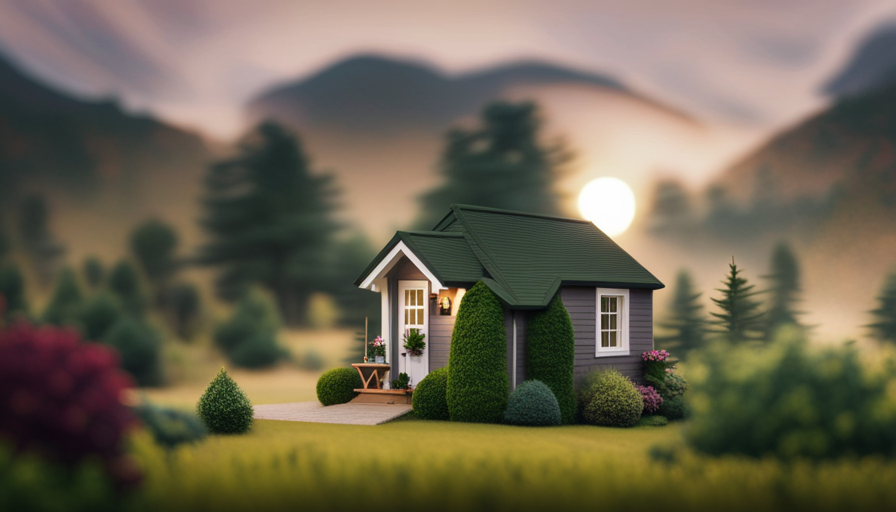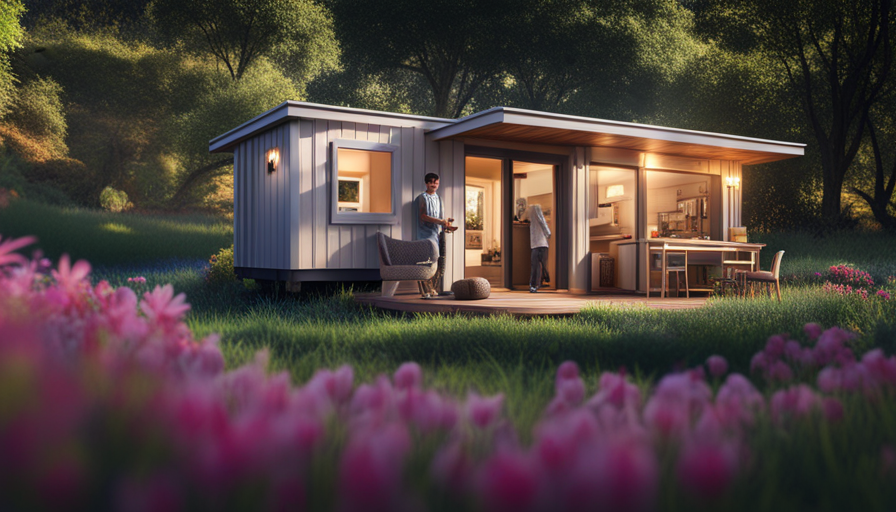In the vast world of sustainable living, tiny homes have emerged as a guiding light for those seeking a simpler and more minimalist lifestyle. Like a single drop in a vast ocean, these compact dwellings offer an opportunity to reduce our environmental footprint.
As I navigate the waters of tiny house living, one question that often arises is: how many gallons of water do you need to shower in a tiny house? This seemingly straightforward query requires some careful calculation and consideration.
In this article, we will dive deep into the world of water usage in tiny house showers, exploring not only the numbers but also the environmental impact and ways to conserve. From installing water-saving fixtures to implementing shower time limits and recycling water, we will explore every nook and cranny to find a balance between cleanliness and conservation.
So grab your towel and join me on this journey as we uncover the secrets behind showering sustainably in a tiny house.
Key Takeaways
- Water-saving technology, such as low-flow showerheads and faucet aerators, can significantly reduce water consumption in tiny house showers.
- Graywater systems can recycle and reuse water from sinks and showers, contributing to water conservation in a tiny house.
- Factors to consider when calculating water needs in a tiny house shower include shower duration, frequency, and available storage capacity.
- Installing water-saving fixtures and utilizing graywater systems are effective ways to conserve water in a tiny house shower.
Water Usage in Tiny House Showers
How many gallons of water do you need to shower in your tiny house? When it comes to water usage in tiny house showers, there are various factors that come into play. One of the key considerations is water-saving technology. Implementing sustainable showering practices can significantly reduce the amount of water used per shower.
In a traditional shower, an average person uses around 17-24 gallons of water per minute. However, with the use of efficient fixtures and appliances, such as low-flow showerheads and aerators, you can cut down on your water consumption without compromising on comfort or cleanliness. These innovative technologies restrict the flow rate while maintaining adequate pressure, ensuring that every drop counts.
By incorporating these advancements into your tiny house shower design, you can minimize wastage and maximize efficiency. Additionally, consider using graywater systems to recycle and reuse water from sinks and showers in tasks like flushing toilets or watering plants. This further reduces the overall environmental impact associated with showering.
Understanding the environmental impact of daily activities is crucial when living in a tiny house. By adopting sustainable practices like utilizing water-saving technology and implementing graywater systems, we can significantly minimize our ecological footprint.
Understanding the Environmental Impact
By being mindful of our resource consumption, we can uncover the true extent of our environmental impact while showering in a tiny house. Water saving technology plays a crucial role in minimizing water usage and reducing our ecological footprint.
Tiny houses often utilize low-flow showerheads and faucets, which restrict the flow rate to conserve water without compromising on functionality. These fixtures typically have a flow rate of around 1.5 gallons per minute (gpm), significantly lower than standard showerheads that can use up to 2.5 gpm. Additionally, some tiny houses incorporate graywater systems, which collect and treat wastewater for reuse in non-potable applications such as flushing toilets or watering plants.
Understanding the environmental impact of excessive water usage is essential in today’s world where water scarcity has become a major concern. By adopting water-saving technologies and practices like those found in tiny houses, we can contribute to conserving this precious resource. The implementation of these measures not only helps us reduce our personal consumption but also raises awareness about the importance of responsible water use.
Calculating your water needs requires careful consideration of factors such as frequency and duration of showers, individual habits, and available storage capacity.
Calculating Your Water Needs
To accurately determine your water requirements, consider taking into account factors such as the length and frequency of your showers, along with your personal habits and available storage capacity. Calculating water consumption in a tiny house shower is crucial for maximizing water efficiency.
Here are three important considerations when calculating your water needs:
-
Shower Duration: The length of your showers plays a significant role in determining water usage. Consider setting a timer to track how long you typically spend in the shower. By reducing shower time by just a few minutes, you can save gallons of water each day.
-
Shower Frequency: How often you take showers also affects your overall water consumption. Assess your lifestyle and personal hygiene preferences to find a balance between cleanliness and conservation.
-
Storage Capacity: Understanding the amount of water you can store in your tiny house is vital. This includes both fresh water for use during showers and graywater storage for recycling or disposal. Be sure to factor in the size of your tanks or containers when calculating your needs.
By accurately calculating these factors, you can effectively manage and conserve water in a tiny house shower. In the next section, we’ll explore tips for conserving water without compromising on cleanliness or comfort.
Tips for Conserving Water in a Tiny House Shower
Maximize your water efficiency in a tiny house by following these helpful tips for conserving in the shower. When it comes to water-saving techniques, there are several things you can do to minimize your water usage without sacrificing comfort.
First, consider investing in eco-friendly showerheads. These innovative fixtures are designed to reduce water flow while still providing a satisfying shower experience. By installing one of these showerheads, you can significantly decrease the amount of water used during each shower.
Another tip for conserving water in a tiny house shower is to be mindful of how long you spend in the bathroom. Limiting your showers to five minutes or less can save a substantial amount of water over time. Additionally, try turning off the water while lathering up with soap or shampoo, and only turn it back on when you’re ready to rinse off.
Incorporating these simple changes into your daily routine will help you conserve both water and energy, making your tiny house more eco-friendly overall. By adopting these water-saving techniques and considering the installation of other efficient fixtures such as low-flow toilets and faucets, you can further minimize your environmental impact without sacrificing convenience or comfort.
So let’s move on to the next section about installing water-saving fixtures that will enhance your overall sustainability efforts within your tiny home setup.
Installing Water-Saving Fixtures
Enhance your sustainable lifestyle in a compact home by installing water-saving fixtures that will revolutionize your daily routine. Water-saving technology has come a long way, and there are now several options available to help you reduce your water consumption while still enjoying a refreshing shower.
One popular choice is a low-flow showerhead, which limits the amount of water flowing through it without compromising on pressure. These showerheads can save up to 50% more water compared to traditional ones, making them an excellent investment for any tiny house owner.
Another option is a faucet aerator, which mixes air with the water coming out of the tap, creating a steady stream while using less water overall. By installing aerators on all your faucets, you can significantly reduce the amount of water wasted during everyday tasks like washing hands or brushing teeth.
Additionally, consider installing a dual-flush toilet that offers two different flush options – one for liquid waste and another for solid waste. This innovative feature allows you to use less water when flushing urine but still provides enough power for solid waste removal.
By incorporating these water-saving fixtures into your tiny house, you can make significant strides in reducing your overall water consumption. With these changes made, let’s move on to explore using greywater systems to further maximize our sustainability efforts.
Using Greywater Systems
When it comes to conserving water in a tiny house, installing water-saving fixtures is just the beginning. Now, let’s talk about using greywater systems.
Greywater refers to the waste water from sinks, showers, and laundry that can be reused for other purposes. By implementing greywater filtration systems in a tiny house, you can further minimize your water consumption and live sustainably.
To give you a clearer picture of how greywater systems work, here are three sub-lists:
-
Collection: Greywater is collected from drains in the bathroom and kitchen.
-
Filtration: The greywater goes through a filtration system designed to remove debris and contaminants.
-
Reuse: Once filtered, the clean greywater can be used for tasks like flushing toilets or watering plants.
By reusing this water that would otherwise go down the drain, you not only reduce your overall water usage but also contribute to sustainable living practices.
Now that we’ve covered using greywater systems in a tiny house, let’s dive into another effective strategy for conserving water – implementing shower time limits.
Implementing Shower Time Limits
To make the most of your shower experience, set a timer and challenge yourself to beat it each time. By implementing shower time limits, you can not only save water but also become more mindful of your water consumption in a tiny house. Setting boundaries for your shower time is essential when living with limited resources.
When it comes to managing water consumption, every drop counts. By limiting your shower time, you can significantly reduce the amount of water used during each session. This means setting a specific duration for your showers and sticking to it religiously. Whether it’s five minutes or ten minutes, find a time limit that works for you and strive to stay within that timeframe.
Shower time limits can be beneficial in multiple ways. They help conserve precious resources like water while also promoting efficiency in daily routines. Additionally, they encourage individuals to think about their impact on the environment and take steps towards sustainable living.
By incorporating shower time limits into your daily routine, you can easily manage your water consumption in a tiny house. It’s an effective way to ensure that you’re using only the necessary amount of water without compromising cleanliness or comfort.
Transitioning into recycling and reusing water in our next section highlights another crucial step towards sustainable living without excessive waste.
Recycling and Reusing Water
Recycling and reusing water is a smart and sustainable practice that can greatly reduce your environmental impact while living in a compact home. By implementing water conservation initiatives, such as recycling greywater from showers, you can significantly decrease your water consumption. Greywater refers to wastewater generated from activities like showering, dishwashing, and laundry that can be reused for non-potable purposes.
To better understand the benefits of recycling water in a tiny house, consider the table below:
| Recycling Benefits | Water Conservation Initiatives |
|---|---|
| Reduces strain on freshwater resources | Installing a greywater filtration system |
| Decreases energy required for water treatment processes | Collecting rainwater for household use |
| Minimizes pollution by reducing the amount of wastewater entering sewage systems | Using low-flow fixtures and appliances |
By adopting these practices, you can conserve precious water resources while minimizing your ecological footprint. Exploring alternative shower options is another significant step towards achieving this goal. These options will allow you to further reduce your water usage without sacrificing cleanliness or comfort.
Exploring Alternative Shower Options
Consider exploring alternative shower options in your compact home, such as installing a water-efficient showerhead or using a steam shower, to further reduce your environmental impact and enhance your bathing experience.
When it comes to alternative shower designs for tiny houses, there are a few key factors to consider: water efficiency and space optimization. Water-efficient showerheads are an excellent choice for conserving water without compromising on the quality of your showers. These innovative devices use advanced technology to regulate the flow rate while maintaining adequate pressure for a satisfying shower experience. By reducing the amount of water used per minute, you can significantly decrease your overall water consumption.
Another option worth considering is a steam shower system. This type of shower creates a luxurious spa-like experience while using minimal amounts of water. Steam showers work by generating steam from a small amount of water, creating a soothing and relaxing environment that can help relieve stress and promote wellness.
Exploring alternative shower options in your tiny house is crucial for finding a balance between hygiene and conservation. Water-efficient showerheads and steam showers are both effective ways to minimize water usage while still enjoying the benefits of regular bathing.
Finding a Balance between Hygiene and Conservation
When it comes to living in a tiny house, finding alternative shower options is crucial. In my exploration of these options, I’ve come to realize the importance of striking a balance between hygiene practices and water conservation strategies.
Hygiene practices are essential for maintaining good health and well-being. However, in a tiny house where resources are limited, it becomes necessary to be mindful of our water usage. This is where water conservation strategies come into play.
To find this delicate balance, one can adopt various techniques. Installing low-flow showerheads or aerators can significantly reduce water consumption without compromising on the quality of the shower experience. Additionally, timing showers and using efficient cleaning products can further minimize water wastage.
Incorporating hygienic habits like taking shorter showers and turning off the water while lathering up can also make a significant difference. Furthermore, collecting and reusing graywater for tasks like watering plants or flushing toilets is an excellent way to maximize resource efficiency.
By implementing these hygiene practices and water conservation strategies in our daily routines, we can ensure that we maintain cleanliness while minimizing our environmental impact in the tiny house setting.
Frequently Asked Questions
What are some common water-saving fixtures that can be installed in a tiny house shower?
Some common water-saving fixtures that can be installed in a tiny house shower include low-flow showerheads, aerators, and water-efficient faucets. These eco-friendly shower options help reduce water consumption without sacrificing performance.
Low-flow showerheads restrict the flow rate to conserve water, while aerators mix air with the water stream to maintain pressure while using less water. Water-efficient faucets have built-in mechanisms that control the flow rate and minimize wastage.
Installing these fixtures can significantly decrease water usage in a tiny house shower.
How can greywater systems be incorporated into a tiny house shower?
Incorporating greywater systems into a tiny house shower can significantly enhance water efficiency. By utilizing this system, water from the shower is collected and treated for reuse in other household activities like flushing toilets or watering plants.
Additionally, incorporating rainwater harvesting further reduces water consumption. When combined with the benefits of composting toilets, such as reducing water usage and providing nutrient-rich soil, a tiny house can achieve remarkable sustainability in its overall water management.
Are there any alternative shower options for tiny house owners who want to conserve water?
There are several alternative shower designs available for tiny house owners who want to conserve water. These designs include low-flow showerheads, aerated showerheads, and water-efficient showers. By using these alternatives, homeowners can significantly reduce their water usage without sacrificing the quality of their showers.
The benefits of water conservation in a tiny house include reduced environmental impact, lower utility bills, and increased self-sustainability. Implementing these alternative shower options is an effective way to achieve these benefits.
How can I calculate my specific water needs for showering in a tiny house?
To calculate my specific water needs for showering in a tiny house, I can start by determining the flow rate of my showerhead. I can measure the amount of water that flows from it in one minute and multiply this value by the duration of my showers to estimate the total water usage. This calculation allows me to optimize my water consumption and promote the benefits of water conservation, such as reducing environmental impact and saving costs on utility bills.
Is it possible to recycle and reuse water in a tiny house shower?
Yes, it’s possible to recycle and reuse water in a tiny house shower. The recycling water process involves collecting the used water, filtering it to remove impurities, and treating it for reuse. This method has several benefits of water conservation. It reduces overall water consumption, minimizes wastewater production, and saves money on utility bills. By implementing this system in a tiny house, you can contribute to sustainable living practices and conserve precious water resources.
Conclusion
In conclusion, conserving water in a tiny house shower is crucial for minimizing environmental impact and maximizing efficiency. By installing water-saving fixtures and implementing shower time limits, we can strike a balance between hygiene and conservation. Additionally, recycling and reusing water are important considerations. Understanding our water needs and finding alternative shower options are also important. So, next time you step into your tiny house shower, remember that every drop counts towards creating a sustainable future. Start making small changes today to make a big difference tomorrow.
Hi, I’m Emma. I’m the Editor in Chief of Tiny House 43, a blog all about tiny houses. While tree houses are often associated with childhood, they can be the perfect adult retreat. They offer a cozy space to relax and unwind, surrounded by nature. And since they’re typically built on stilts or raised platforms, they offer stunning views that traditional homes simply can’t match. If you’re looking for a unique and romantic getaway, a tree house tiny house might just be the perfect option.










